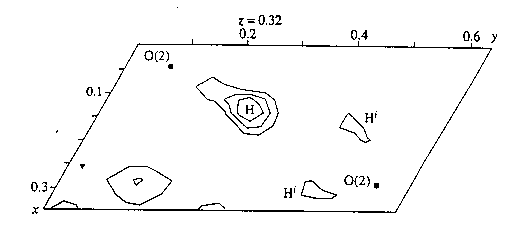
EFFECT OF ANOMALOUS MANIFESTATION OF HYDROGEN ATOMS ON ELECTRON DENSITY MAPS IN SUPERPROTONIC PHASES HAVING A DYNAMICALLY DISORDERED HYDROGEN BOND NETWORK
B.V. Merinov
Shubnikov Institute of Crystallography of the Russian Academy of Sciences, Leninskü pr. 59,117421 Moscow, Rusšia
Determination of hydrogen atom positions in X-ray studies of hydrogen-containing compounds is quite complicated problem because of the low scattering factor of this atom. In superprotonic phases having a dynamically disordered hydrogen bond network (DDHBN), the problem seemed to be unsolvable, because of low occupancies of corresponding hydrogen atom positions. However, in the structure determinations of the superprotonic phases of some crystals of the MHAO4, M3H(AO4)2 and M5H3(AO4)4·xH2O families, where M=NH4, K, Rb, Cs; A=S, Se, a novel effect - anomalous manifestation of hydrogen atoms on electron density maps - was for the first time revealed [1]. It turns out, peaks of electron density corresponding to the dynamically disordered hydrogen atoms with position occupancies 1/6, 1/12 and even less are clearly seen on the electron density maps. As one of the examples, a fragment of the difference electron density map of the superprotonic Cs3H(SeO4)2 phase is shown in the figure. The main pathways of proton transport in the M3H(AO4)2 compounds lie in the (001) plane, where the proton conductivity reaches superionic values (s~10-2 S·cm-l, Ea~ 0.3 eV}. However, although the conductivity along the [001] direction is less than in the perpendicular plane, nevertheless its value remains fairly high (s ~10-4 S·cm-l, Ea~ 0.6 eV). In order to interpret this experimental fact, in addition to the "principal" 16(h) hydrogen position, in the frame of which the proton transport in the (001 ) plane can be described, the "supplementary" (or defect) 36{i) hydrogen position was assumed to explain the relatively high conductivity along the perpendicular [001] direction. The occupancy of the principal position is about 1/6, whereas the occupancy of the supplementary position is much lower [2, 3]. The analysis of the electron density distribution in the superprotonic phase [1] resulted in the following revelation. Both positions are clearly seen on the corresponding electron density maps (see the figure).

A fragment of the difference electron density map of the superprotonic Cs3H(SeO4)2 phase. The peaks denoted by H and H' correspond to the hydrogen atoms in the "principal" 16(h) position and in the "supplementary" 36(i) position respectively. Isolines are drawn at a step of 0.1 eA.
The effect of anomalous manifestation of hydrogen atoms is a stable phenomenon which is observed in all examined superprotonic phases having a DDHBN. This absolutely surprising experimental result is difficult to explain using traditional approaches. At first glance, the formation of the DDHBN is the most obvious general feature of the atomic structures of the superprotonic phases studied. Nevertheless, at present, one cannot state definitely whether this is the main reason of the anomalous manifestation of the hydrogen atoms or there exist other, more latent reasons. Possibly, the hydrogen sublattices having some specific features in the superprotonic phases with DDHBN, make alterations in X-ray diffraction patterns, which result in the anomalous manifestation of hydrogen atoms on the corresponding electron density maps.